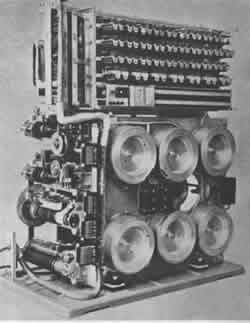While AT&T blocked most attempts to use recording devices on telephone wires in the U.S., in Europe the situation was different. There were several products available in the 1920s, based on the Poulsen Telegraphone, that could be used to make telephone recordings. A landmark in the development of the automatic answering machine came in 1936 with the appearance of the Swiss answering machine called the Ipsophon, a magnetic recorder using steel tape. Ipsophons were intended to be used by large offices or by the telephone companies themselves. Users accessed their messages by “dialing in” to the machines–in other words, this was not a machine for the individual or the home. The Ipsophon survived World War II and re-appeared in the United States in the late 1940s. Although it was technologically obsolete by that time it had been modified so that users could pick up their recorded messages remotely, just as we do today. To check the messages, the owner of the machine called his or her own number, waited for the machine to answer, and used a whistle to activate the playback mechanism. Electronic filters, tuned to receive the tone of the whistle, detected the signal. While the security of the system was weak, it probably represents the first use of this remote-access feature.

